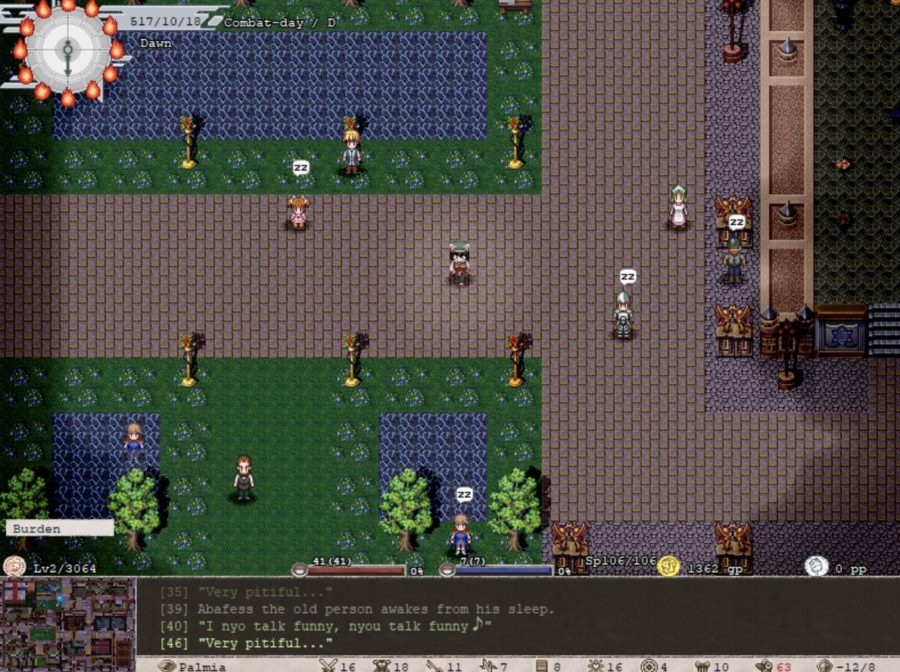Elona+: Quirky, Eccentric and Completely Bonkers
What this unusual game has to offer
Elona+ is a truly unique gaming experience that has me completely hooked. There is not a single game that even comes close to it–not to mention it is free for all it offers. Elona+ is a roguelike open-world video game that allows players to play any role they please, offering a range of character classes and races that appeal to many different playstyles. Even though open-world games are nothing new, Elona+ takes a unique approach with incredibly intricate mechanics with a remarkable amount of depth that gives the game an interesting flavor. Whether players seek bloodshed or fancy a more peaceful experience, Elona+ includes options for all.
The first thing Elona+ has the player do is create a character by having them choose their avatar’s name, title, appearance, personality, backstory, race and class. Only race and class significantly impact gameplay and are the main determiners of playstyle. Races and classes have special bonuses that cater to different abilities and stats; for example, the Wizard class and Lich race accommodate magic users as they start with higher magic stats and a larger mana pool. The game also includes bonus races and classes for players seeking special challenges, such as the Mutant and Fairy, which were fun to try once I had played for a while. After the player creates their character, they can complete a tutorial which introduces the first two main characters. The game officially begins after the player leaves the starting area, freeing them to do anything they want.
While Elona+ includes a tutorial that teaches the player the basics, the game could be more welcoming to new players and can be overwhelming at first. The early game is challenging to navigate and I recommend the Elona Wiki and other online guides, which are very useful for knowing what to expect. Elona+ gives its players freedom, but almost no direction, and I believe that the game would benefit from a more in-depth tutorial or an in-game guide.
The player will likely enter their first combat situation shortly after starting. The combat system is turn-based, with actions like casting spells, attacking, interacting with objects or moving take a number of turns. You can reduce the number of turns an action takes by increasing the character’s speed, though early in the game the player will likely have a single turn to complete an action before their opponent has their own. Even though the game is turn-based, the game does not switch to a special screen to indicate a battle triggering, however the appearance of health bars indicates the beginning of a combat situation.
After grasping how combat worked in-game, battles were relatively straightforward and fun. Deciding on what action to take next while fighting formidable opponents was thrilling, and shredding through less threatening enemies was satisfying. The game randomly generates dungeons all around the map after specific periods, which are usually proportional to the player’s level. After completing most of the story’s challenges, conquering difficult dungeons was always a reliable way to engage in tougher battles after the static in-game dungeons became too easy. Even so, combat still felt repetitive sometimes, and spontaneous encounters could even get annoying. Finishing some quests and obtaining certain items can only be completed by visiting dungeons, and I spent most of my time in-game in dungeons.
Another part of combat is pets–allies that can pack an extra punch in battles. Pets can train and level up just like the player character and become especially important towards the late game. For exceptionally experienced players, strong pets become a necessity. You can get one pet early in the town of Vernis and have opportunities to get more later in the game. Many pets have abilities, such as spells, stat bonuses or special actions. Pets are relatively easy to train and can even surpass the player character’s strength. Finding and capturing good pets is a difficult but rewarding task, and it was fun to see my pets get stronger with my character. It is nice to see a game where allies can be helpful and watching my pets instantly shred enemies to pieces was very satisfying. The AI for some of the pets is crude though and creatures that might make good pets are often hindered by their inability to perform useful functions.
The non-combat aspect of Elona+ is very well done for the most part and just as entertaining as the combat. Other than combat, Elona+ offers other activities to keep the player entertained. Players can breed pets in a ranch, complete quests, obtain food and other goodies by farming, create a money empire, and decorate their homes, among other things. There is no shortage of things to do in Elona+, and many of the activities listed above have skills associated with them that can be trained, just like combat skills. The skill tree in Elona+ is extensive and highly complex, ranging from skills like gardening to pickpocketing. Elona+ has upgraded visuals from the original Elona game, featuring new sprites and updated character art. The pixel art is nice, though sometimes things can be difficult to see on screen as the characters and backgrounds can sometimes appear blended. The art style is cute and contains an impressive amount of detail despite being pixel art, and the game is visually pleasant overall.
The characters in Elona+ are a minor part of the overall experience but they are entertaining to watch, nonetheless. NPCs (Non-player character) can often be seen Aside from less notable characters, such as bartenders and shopkeepers, Elona+ features a small cast of characters relevant to the story. Many of them cannot directly interact with in-game, but those that can, do not have anything interesting to say for the most part.
The major characters seen in-game can engage in shenanigans just like regular NPCs, which can result in some comical interactions. Each town also has its types of people and memorable NPCs with charming appearances and personalities. However, the game’s purpose is not to show a moving story with compelling characters, though some of the cast has a surprising amount of development and solid backstories despite this. Elona+ is not a game to be noted for its characters though and those looking for such a game should search elsewhere.
Elona+ features an extensive soundtrack that expands upon the original game. The soundtrack is no masterpiece, but it does the job as intended, and some of the songs I even listen to outside of playing the game. The soundtrack consists of orchestral music typical to a fantasy setting and has an excellent range of lively battle pieces to more relaxing songs. Some of the towns and the main themes are quite beautiful and set the game’s atmosphere nicely. Overall, the game has a decent soundtrack with some memorable pieces.
Elona+ is a game that I’ll never truly get tired of. The gameplay is highly addicting, and the game still has challenges no matter how high your character’s level gets.This game is worth trying out for people who enjoy fantasy RPGs. However, you should note that the original game was developed in Japanese, so some of the English can look nonsensical. That aspect only adds to the game’s charm in my opinion, and I would highly recommend Elona+ to anybody interested. Despite its flaws, I love this game to bits. There really is nothing like Elona, and I am happy to be a member of its community.
What did you think about this story? Do you have any suggestions for improvements or other articles that you would like to see? Please use the contact form to communicate with us! (Keep all information school-appropriate)
https://docs.google.com/forms/d/e/1FAIpQLSeRYRWwLLzvs2rqwHSGdr-DQRvxhUSx9UcaXypXxnvVuCqwyA/viewform










